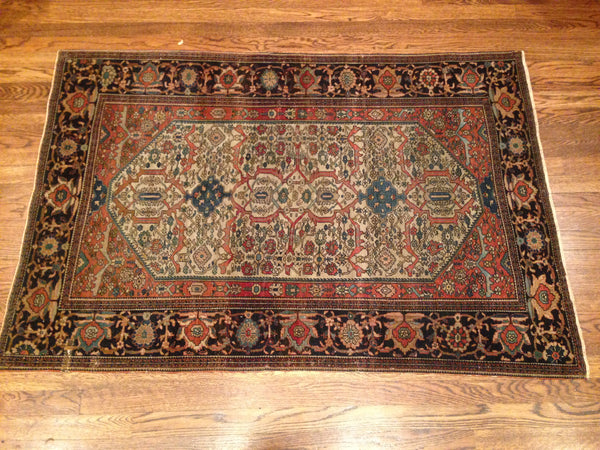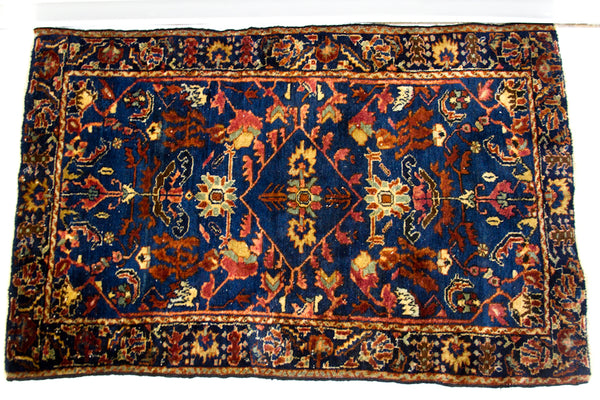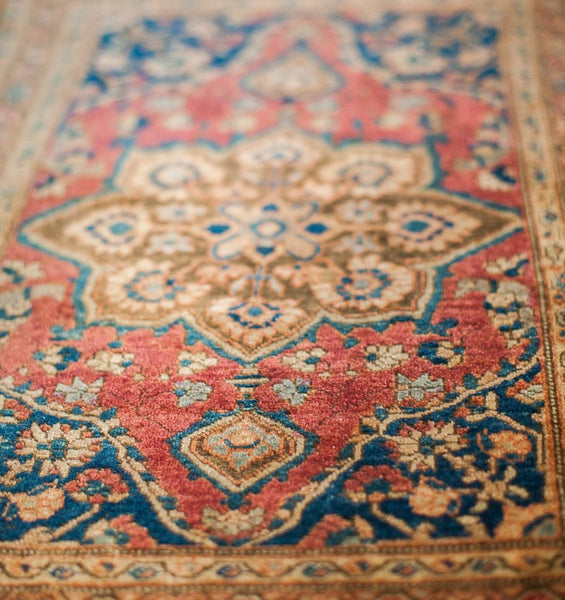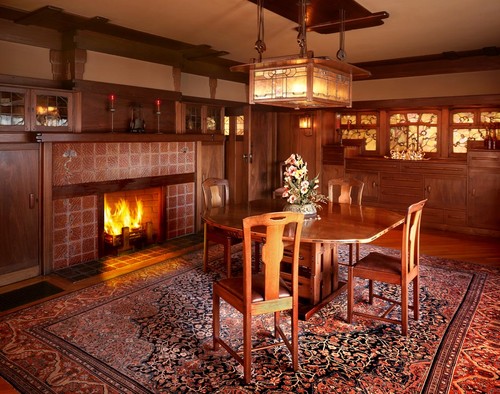A Guide to Sarouk Carpets

Carpets of Persian origin are often named after the people or area/location the carpets are made. At times, the trading point for outlying areas also may stand as part of attribution too. More specific designations, names, prefixes or other are assigned to specific types of carpets. Sarouk carpets are among the most timeless and coveted Persian Rugs of the 19th and 20th centuries. We're going to delve into the different types of Sarouk carpets, and distinctions those in the industry would generally consider accepted relations and delineations.
Sarouk is somewhat of a overall area of carpet production in Persia. Most carpets attributed to Sarouk were made in areas contained within the region of what is the Markazi province and many were routed through Arak, Iran. Within the area surrounding Arak, weavers from workshops, towns and surrounding dwellers supply the markets and export.
There are several important types of Sarouk carpets to differentiate between and also draw connections to. As one of the most important weaving areas of Iran in the 19th and 20th century, it is our pleasure to introduce the Old New House super Sarouk helpful guide and overview:
Short overview:
The main stream connection between all Sarouk carpets 19th to 20th centuries generally follows as such - Farahan Sarouk production transitions to Mohajeran Sarouk which transitions into American / European and German Sarouk. These are going to be the major carpets to look for and differentiate between. Variations of carpets with Sarouk suffix are often offshoots of these major types either in design and proximity, and/or related in technical characteristics.
Detailed overview:
19th Century
To clarify a common blurred overlapping distinction and attribution due to similarity, Feraghan is generally not to be confused with Farahan Sarouk. Fereghan is an outlying carpet of the Arak area and is generally considered its' own entity aside from Sarouk rugs as a whole, although woven within relatively close proximity. Fereghan carpets are typically very thin in characteristic, loose in knotting although of good weave, wool, and brilliant colors most often featuring rectilinear designs. The most popular of these designs includes Guli Hanai and Herati although they come in a wide array of styles, designs and motifs. While highly sought after and still considered Arak weaving overlap they are not to be confused with Sarouk or Farahan Sarouk production which is closer to the cities. Fereghan rugs are generally more related to Sultanabad, Mahal and general Arak weaving which exhibit looser weave density overall. Farahan Sarouk / Sarouk Farahan is is town/workshop weaving with mostly curvilinear mapping.
 An antique Palace Size Fereghan Carpet. These are among the most sought after 19th century carpets known for wonderful depth and saturation in color, as well as rhythmic geometric motif in allover design. Although woven in relatively close proximity to Sarouk, these carpets are made in what was the Fereghan Plains area of Persia, more removed from the city, and more village and town oriented weaving. Fereghan carpets generally are documented as having approximately 90 knots per inch, with roughly 30-45 degree warp offset (meaning both nodes of the knot may be seen, one portion more so than the other). Most commonly the span of weaving covers the early 1800's through 1915. The majority of examples will be found in the 1880-1910 range.
An antique Palace Size Fereghan Carpet. These are among the most sought after 19th century carpets known for wonderful depth and saturation in color, as well as rhythmic geometric motif in allover design. Although woven in relatively close proximity to Sarouk, these carpets are made in what was the Fereghan Plains area of Persia, more removed from the city, and more village and town oriented weaving. Fereghan carpets generally are documented as having approximately 90 knots per inch, with roughly 30-45 degree warp offset (meaning both nodes of the knot may be seen, one portion more so than the other). Most commonly the span of weaving covers the early 1800's through 1915. The majority of examples will be found in the 1880-1910 range.
Farahan Sarouk (or Farahan Sarouk) carpets are often colorful, semi-formal, and full of character. See example below of a very expressive and rare cloudband motif Farahan Sarouk:

Note the even balance in design, excellent execution and rendering of curvilinear design elements such as the cloudband and other clearly defined flowers. A unique and rare example of Farahan Sarouk carpets circa 1900.
Farahan Sarouk typically feature a dense weave with knot count in the range of 130 - 240 knots per inch with the average example showing in the area of 140-180. We have seen rare and exceptionally fine examples to have in excess of 300 knots per inch. A very limited run of silk Farahan rugs made between 1860's-1890's feature multi-color silk warps and exceptionally high knot count in the range of 300 - 450. Farahan Sarouk rugs are very solid rugs generally woven with great wool, weave and colors. Earlier examples date back to the first half of the 1800's, and later examples go a bit into the 20th century. However, most Farahan Sarouk rugs will be found in the 1875-1915 range, with earlier examples having rather large designs with open color space and fine knotting, and later examples showing higher level of details and rather low density of open area.
Covering third quarter 19th century weaving through 1920, the more "affordable" alternative to Farahan Sarouk would be Josan Sarouk: slightly coarser, often a bit more open in design, slightly more garish in colors, at times even a bit more irregular in design mapping or even shape. These too can have tremendous character, and with the right attributes, can appeal to the collector community. Another alternative to Farahan and Josan Sarouk carpets are third quarter 19th century through end of 1st quarter 20th century Malayer Sarouk. Malayer Sarouk carpets are often similar to Josan Sarouk in color character and design, although Malayer Sarouk is single wefted, and weave may appear to have finer horizontal knotting. Since the structure is different, many simply call these Malayer rugs, although they are closely related to the Sarouk in proximity and design. Similar to Josan, some of the garish colors and irregularity of a village weave may be evident.
20th Century:
With movement into the 20th century, finer Farahan Sarouk workshop manufacturing transitions into Mohajeran Sarouk in the late 1800's. Mohajeran Sarouk carpets a draw an important relation and connection between 19th century and 20th century production of Sarouk Iran. Mohajeran catered to an increasing European demand: Persian designs and execution, some with a hint of a looser more airy space between designs in the field and a more "blossom" oriented design and particularly heavy emphasis on a willow tree motif. Typically bolder and more traditional reds and blues were main colors of choice. Mohajeran Sarouks are often feature deep rich cobalt blue backgrounds with a hint of a royal blue or, more commonly, deep red fields. Often the colors paired are inverse: Red with blue border, or blue with red border. However, there are unique exceptions to this. Some blue carpets may be found with a salmon terra cotta border, and others with a deep ruby, or even an eggplant tone. Other than a willow tree repeating across the carpet - designs may include delicate vines, floral clusters and open space between motifs. In comparison to its predecessor, overall, a highly decorated Mohajeran Sarouk would likely have slightly fewer quantity and range of colors than the Farahan Sarouk. Some hint this may be a reflection of the times in and around WWI, although much of Mohajeran production precedes this. Medallions were less frequently woven in Mohajeran as they were in Farahan Sarouks. Many Mohajerans have covered fields, or allover designs. Some earlier pieces have horizontally elongated medallions. In these pieces, you can often clearly see similarities and transitional use of borders and outlines as strong reminders of the Farahan Sarouk.
Eventually this Mohajeran style was overlapping what is now referred to as the American and European Sarouks which began transitioning around 1915-1925, then later gained a great deal of momentum in the late 30's. Floral sprays in allover covered fields become very popular in American Sarouks of the late 1920's through 1950's with continual refinement along the way. The design is so well identified in Western and European markets the motif is even adapted in village and even nomadic weaving. Such is the case with Lilihan Sarouk (single weft) which in the early late 19th century, and moreso in the 20th century) designs were quite similar to end of run Mohajeran style and American Sarouk. The main difference being structure - single weft construction and generally a more cost conscious investment. Mid century Lilihans pieces are to be considered commercial grade rugs with coarser weave, and lower grade wool. Many Lilihan Sarouks were also painted similar to American Sarouks.
Sarouk Rugs and Offshoot Sarouk Variety:
American Sarouks, European Sarouks and German Sarouks: Primarily made from 1920 - 1960. The style of these carpets predominantly encompasses traditional Persian and European flavor with floral bouquets and sprays atop red or blue fields. Many of these rugs were painted to satisfy market demands for highly enriched saturated colors rather closely related to jewel tones in intensity. Intense salmon pink backgrounds of American Sarouk rugs were often painted with a rich raspberry / cherry red giving the carpets an unmistakable and brilliant ruby tone. Sarouks were not only painted red - other colors aside from field color that were altered include greens, blues, yellows, and more. Sarouk rugs of this type are generally very ornate, curvilinear and formal. Knot density for Sarouks of this variety generally remains between 100 - 180 knots per inch, with some examples venturing into the 225 kpsi range. An interesting point that is often overlooked in comparing Sarouk rugs of similar age and character but different size is this: It is common for Sarouk rugs of this 1920's-60's vintage in sizes smaller than 5x7 to have up to 30% higher knot count on average than larger sizes. This was a correction made to compensate for design detail often lost when scaling motifs smaller. The average example in 9'x12' often has approximately 120 knots per inch, while a small Sarouk of the same vintage and type may have 150 knots per inch or more. The pile of Sarouk rugs vintage 1920-60 is comparably thicker ranging from 1/4" to nearly 3/4". Similarly, Sizes are generally small scatter sized carpets all the way up to mansion, palace and highly unusual large dimensions exceeding 14' x 24'. Runners are a bit more unusual to find as are rugs with a blue background.
Arak - Some post WWI American Sarouks and Mir Sarouks are incorrectly attributed as Sarouks when they are really Arak: Although all come from the Arak area, if a suspected 'Sarouk' carpet is double wefted and under 100 kpsi, it is more properly and simply attributed to Arak, implying more rural, looser weave with less of a workshop oriented production.
Farahan - See above.
Fereghan - Typically older carpets pre-1920's. These are rectilinear design with repeating herati or tree/pomegranite and Guli Hannai motif. From afar, the affect is somewhat similar. Distinguishing characteristics thin carpets often featuring a minor color of copper green / celadon often found in the border. Very early examples from the first half of the 1800's have green dye/mordant which is of detriment to the wool, and therefor tends to recess the pile height. Predominant field colors are Dark blue. Harder to find is red, and even more rare is ivory or any other color. Some medallion Feraghans were made, although disproportionately smaller numbers. These carpets are woven relatively close to the major trading post in Arak.
Josan Sarouk - Generally 19th century examples through 1920 will be 20-40% coarser version of a Farahan Sarouk ranging in weave density of 130 - 180 kpsi. Often found to have slightly more garish color tones: Exaggerated reds, orange or other minor colors. This can be attributed to the types of dyes available to and procured by the weavers of the area. 1920's - 1960's Josan rugs are may be found closer to 200 kpsi. A common identification for mid century Josan Sarouks is Sarouk quality and technical structure with a minor scalloping detail around running border and field motifs.
Malayer Sarouk - Similar to a Jozan Sarouk in design and color, yet single wefted and finer in weave.
Mohajeran - See above.
Mir Sarouk - Some very old Farahan carpets have a Mir [boteh] design, although the Mir Sarouk really has characteristics more closely related in structure to American Sarouk carpets. Mir Sarouk is truly an adaptation of Serbend or Malayer style, simply created in the thicker mid-century weave.
What to look for:
Sarouk rugs are among the most sought after rugs in the World. Simply because a carpet is attributed to any one of this type or vintage does also not necessarily reflect a certain quality. However, distinguishing between the different types is since it educates you as a consumer about a product which is relatively unbranded. Hopefully you will be able to use information provided to you to cross reference information in this article. In the long run, you should know what you have. Is the carpet more appropriately considered a Farahan Sarouk, Josan Sarouk, or maybe neither? Is it a late Farahan or early Mohajeran? Is the carpet you are shown an American Sarouk being placed as 30 years older than American Sarouks were made? These are helpful distinctions to be able to ascertain as a buyer since part of the fun of rug ownership is understanding the lineage and progression of designs, and of course, being able to tell your friends about it!
When looking for the right Sarouk to purchase, bear in mind the following points and tips.
For 19th century Sarouk -
Some Farahan Sarouks were made extremely tight on the loom, which prevents some varieties from being folded like a blanket. Understand a carpet with hard spots or long splits will likely be a purchase purely for decorative value. Ivory grounds are considered more unique and desirable.
20th century Sarouk. This variety are often considered as more formal in nature. Therefore, condition is of utmost importance. Always look for well cared for carpets if purchasing Mohajeran, American/European, Lilihan, Mir or other Sarouks of the 20th century. Late 1st quarter and second quarter Sarouks were often painted. Most commonly the rose-red would be darkened to a burgundy. Other colors to be painted were dark blue. Even further was painting of lime green, rose, medium blue and even orange. Painting is not a problem, but you will want to be cautious of :
1. stripped painted rugs
2. poorly painted rugs or severely worn painted rugs.
Stripped or painted rugs will often be a rose tone with a slight overcast color of brown/orange/gold. If you part the pile deep, you may find the true color. Sarouks stripped of their paint tend to be less desirable. At 1' away from the pile of a poorly painted Sarouk it will look sloppy and hurried. A worn painted Sarouk will have a Halo appearance around floral bouquets. As with most carpets, the most desirable of the type will be that which is well cared for. This is especially true for any carpet with "formal" appeal.
Purchase from a trusted source and consider every rug on an individual basis. Most important, buy what you love since a fine hand knotted rug will last for many years if not generations.
PHOTO GALLERY
A unique Farahan Sarouk with mir boteh field. Approximate weaving date circa 1890. (NFS)

A familiar border design, although very rare field design featuring samovars, pomegranates and herati design. Formerly NFS, this Sarouk Farahan circa 1900 is now available for purchase.

A fine Farahan Sarouk circa 1890.

A very fine Josan Sarouk circa 1915.

A very old Lilihan Sarouk circa 1895 or earlier. (sold)
A very fine and unusual Lilihan Sarouk. Minor painting circa 1930, carpet may pre-date 1915. (sold)
A very late Mohajeran Sarouk mat circa 1920.

A very late Mohajeran Sarouk circa 1920. Note the border similarity to Farahan Sarouk, and field similarity to later American Sarouk. (sold)

An unpainted American Sarouk Circa 1925. (sold)
A typical design of American Sarouk (painted). Weave of exceptional density, age circa1930. (sold)
A typical painted American Sarouk circa 1935.

A fine, unpainted American Sarouk circa 1950. (sold)

An unusual and rare orange Mir Sarouk circa 1940. (Formerly NFS, this Mir Sarouk is now available.)

Where are some famous places you may find Sarouk Rugs?
In the public eye, Sarouk rugs can be found in many corporate and museum collections, state and government buildings, colleges and universities as well as historic homes.
One example is the Gamble House in Pasadena California, which for many years was home to a variety of Farahan, Lilihan and American Sarouk rugs. A historic national landmark iconic of the Arts & Crafts style designed by Charles and Henry Greene in 1908 for David and Mary Gamble of the Procter and Gamble Company. This home has a tremendous legacy and history, with unbelievable detail, amazing quality and a masterpiece of the era. Among other cameos in film, the Gamble House appeared in the Back to the Future films as Doc Brown's home in 1955. Read more about the Gamble House on Wikipedia.

Image ©Tim Street-Porter, The Gamble House.
See how many Farahan Sarouk rugs you can spot in an Arch Daily article on The Gamble House.
What is the most expensive Sarouk to ever sell?

Sotheby's Lot 151, CARPETS, November 25, 2008 sold for $50,000.
Relative to size and sale price, among the most expensive wool Sarouk rugs to sell in a public venue was an allover cloudband design ivory Farahan Sarouk circa 1900 measuring 4'4" x 6'8" which sold in 2008 at a NY Sotheby's for $50,000 USD, or $1,730 per square foot.

Sotheby's Lot 158, CARPETS, November 25, 2008 sold for $50,000.
Relative to size and sale price, among the most expensive silk Sarouk rugs to sell in a public venue was a center medallion ivory field Sarouk Farahan carpet circa 1900 measuring 4'4" x 7' with polychromatic silk warps which also sold in Sotheby's NY for $50,000 USD, or ~$1,650 per square foot.
| Sarouk Type |
Age Range |
KPSI |
Color Count |
Dave's additional notes |
| Josan Sarouk |
1900–1940 |
~110–180 |
5–9 |
Often village scale, curvilinear but simpler drawing than Arak/Sarouk; balanced palettes |
| Farahan Sarouk |
1850–1930 |
~140–330 (fine) |
7–14 |
Highly collectible; crisp drawing; elegant medallions and Herati variants; earlier = better wool/greens |
| American Sarouk |
1915–1950 |
120–180 (some to 225) |
6–10 |
Primarily export-refinished for US market; deep rose fields; robust pile |
| German Sarouk |
1915–1940 |
140–280 in unusual cases |
8–12 |
Export pieces for European markets; often heavier structure, modified palettes |
| Arak Sarouk |
1925–1955 |
90–120 |
5–9 |
Workshop-industrial scaling from Arak/Markazi; simpler woven structure; commercial efficiency |
| Mohajeran Sarouk |
1885–1930 |
180–250 |
8–12 |
Top-tier workshop quality; luminous wool; strong navy/rose palettes; refined drawing |
OLD NEW HOUSE
































